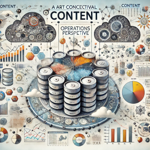 The oil and gas industry continues to experience transformative change, driven by technological advances and the growing demands for efficiency, sustainability, and resilience. While drilling, containment, control, and distribution innovations remain critical, the focus on a holistic systems perspective has become a cornerstone of digital transformation in the sector. This approach is no longer a new idea but a necessary strategy for survival and growth in a competitive and rapidly evolving energy landscape.
The oil and gas industry continues to experience transformative change, driven by technological advances and the growing demands for efficiency, sustainability, and resilience. While drilling, containment, control, and distribution innovations remain critical, the focus on a holistic systems perspective has become a cornerstone of digital transformation in the sector. This approach is no longer a new idea but a necessary strategy for survival and growth in a competitive and rapidly evolving energy landscape.
The concept of the Digital Oilfield—aligning information technology with the core objectives of the petroleum business—has matured significantly since its early days. Today, it is about more than just centralized data collection; it is about turning that data into actionable insights that drive real-world results.
Beyond Data Acquisition: The Intelligence Era
In the early 2010s, many digital oilfield initiatives focused on data acquisition—collecting volumes of information from drilling operations, sensors, and control systems. Fast-forward to 2025, and the emphasis has shifted toward data intelligence. With advanced tools like artificial intelligence (AI), machine learning (ML), and real-time analytics, the industry can now predict failures, optimize drilling operations, and enhance decision-making at an unprecedented scale.
Steve Hinchman, Senior VP of Worldwide Production at Marathon, emphasized this point in a 2006 speech at the Digital Oil Conference, stating:
"Quality, timely information leads to better decisions and productivity gains. Better decisions lead to better results, greater credibility, more opportunities, and enhanced shareholder value."
This timeless insight underscores the continued relevance of high-quality, timely information in driving innovation and operational excellence within the industry.
For instance:
- AI-driven systems analyze vast amounts of historical and real-time data to optimize drilling schedules and reduce downtime.
- Edge computing enables faster decision-making by processing critical data directly at the source, such as remote oil rigs.
- Digital twins—virtual replicas of physical assets—allow operators to simulate and predict the performance of equipment and entire facilities, reducing maintenance costs and increasing operational efficiency.
A Renewed Focus on Purpose
The digital oilfield of 2025 goes beyond providing timely information—it focuses on delivering contextual insights tailored to specific operational goals. By integrating AI-powered decision-making, companies can align their IT systems with shareholder value and broader objectives like environmental responsibility and sustainable energy production.
Challenges and Opportunities Ahead
While digital oilfields have come a long way, challenges remain. The integration of legacy systems, cybersecurity threats, and the pressure to reduce carbon emissions are persistent hurdles for the industry. Yet, these challenges also present opportunities:
- Cybersecurity advancements are safeguarding critical infrastructure against sophisticated attacks, ensuring data integrity and operational continuity.
- Carbon footprint monitoring through real-time emissions data is helping oil companies stay compliant with global environmental standards while demonstrating their commitment to sustainability.
- Interoperability standards enable the seamless integration of disparate systems, fostering collaboration across the energy ecosystem.
The Road Ahead
As the energy industry balances the realities of fossil fuel demand with the need for decarbonization, the digital oilfield will remain a critical enabler of transformation. In the years ahead, the integration of AI, IoT, and cloud technologies will continue to drive smarter operations, enabling oil companies to make better decisions, improve productivity, and enhance shareholder value.
The digital oilfield's future lies in leveraging technology for efficiency and adopting a purpose-driven approach that aligns with evolving business and societal priorities. As we move toward 2030, the companies that succeed will be those that embrace innovation while keeping a clear focus on creating value across all dimensions—economic, environmental, and social.

 Closing Thought
Closing Thought
The Digital Oilfield in 2025 demonstrates that technology is not merely a tool for operational efficiency but a catalyst for reimagining the future of the oil and gas industry. As we navigate toward 2030, the convergence of advanced technologies and purpose-driven strategies will define the leaders in this sector. Those who adapt will not only achieve greater efficiency and shareholder value but also set new standards in sustainability and resilience. The ultimate challenge—and opportunity—is to harness these innovations to create a balance between meeting the world’s energy needs and shaping a more sustainable future for generations to come.
Blog by Mark Reynolds, updated December 2024.


